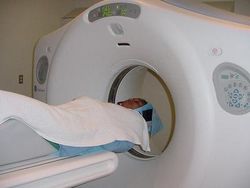|
From rxpgnews.com Lung
Lung cancer can be detected at its very earliest stage in 85 percent of patients using annual low-dose CT screening, and when followed by prompt surgical removal, the 10-year survival rate is 92 percent. These results, to be reported in the October 26 New England Journal of Medicine, would dramatically decrease the number of deaths from lung cancer � the number one cause of cancer deaths among both men and women in the U.S.
Among the 31,567 people in the study, CT screening detected 484 people who were diagnosed with lung cancer, 412 of whom were Stage I. Of the Stage I patients who chose not to be treated, all died within five years. Overall, the estimated 10-year survival rate for the 484 participants with lung cancer was 80 percent. The participants were 40 years of age and older and at risk for lung cancer because of a history of cigarette smoking, occupational exposure (to asbestos, beryllium, uranium or radon), or exposure to secondhand smoke. "We believe this study provides compelling evidence that CT screening for lung cancer offers new hope for millions of people at risk for this disease and could dramatically reverse lung cancer death rates," said Dr. Claudia Henschke, the study's lead author and principal investigator who is chief of the chest imaging division at NewYork-Presbyterian/Weill Cornell and professor of radiology and cardiothoracic surgery at Weill Cornell Medical College. Since the early 1990s, there have been remarkable advances in CT scanners. Sub-millimeter "slicing" can now be applied to the entire chest in a single breath-hold. As a result, lung cancer may be detected when it is smaller than it was possible to diagnose previously. Although CT scans once yielded only 30 images, current technology yields over 600 images. As the technology advanced, the approaches for studying the usefulness of this technology have also advanced. The charge for a low-dose CT screening varies, but ranges from $200 to $300. Treatment for Stage I lung cancer is less than half the cost of late-stage treatment. Estimates of the cost-effectiveness of CT screening for lung cancer are similar or better than those for mammography screening for breast cancer. All rights reserved by www.rxpgnews.com |
